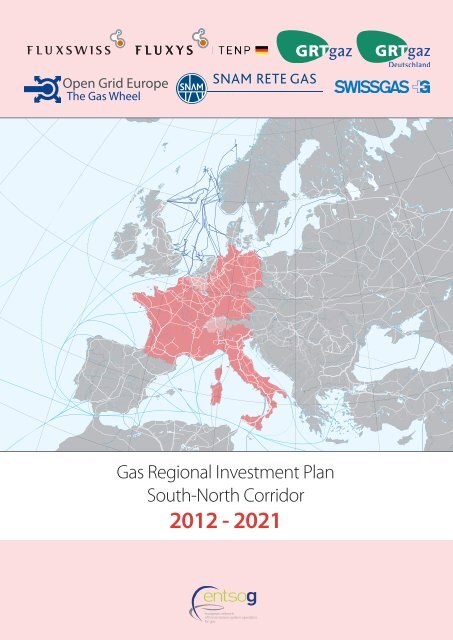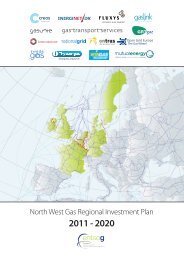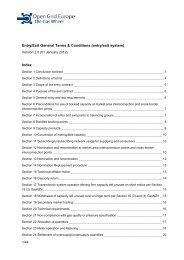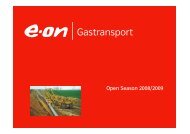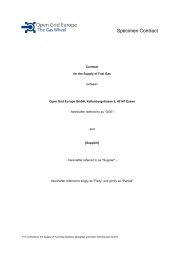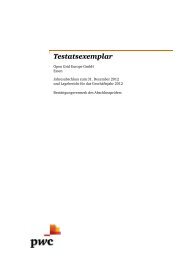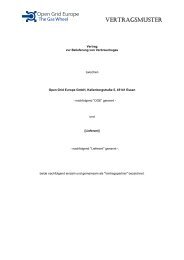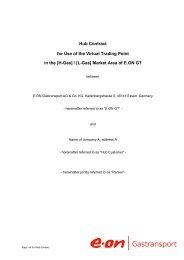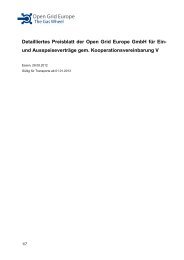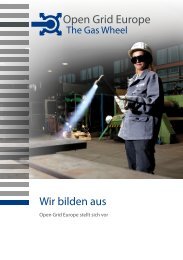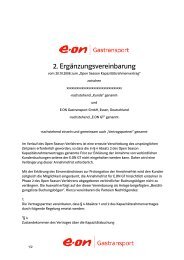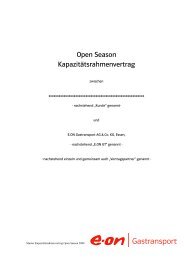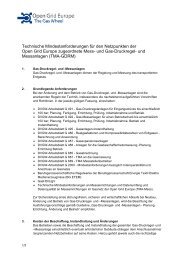Gas Regional Investment Plan South-North Corridor - Snam Rete Gas
Gas Regional Investment Plan South-North Corridor - Snam Rete Gas
Gas Regional Investment Plan South-North Corridor - Snam Rete Gas
You also want an ePaper? Increase the reach of your titles
YUMPU automatically turns print PDFs into web optimized ePapers that Google loves.
Cluden<br />
<strong>Gas</strong> <strong>Regional</strong> <strong>Investment</strong> <strong>Plan</strong><br />
<strong>South</strong>-<strong>North</strong> <strong>Corridor</strong><br />
2012 - 2021
2 List of contents<br />
List of contents<br />
1. FOREWORD...................................................................................................................................................................... 4<br />
2. INTRODUCTION...............................................................................................................................................................5<br />
3. REGIONAL OVERVIEW.................................................................................................................................................. 6<br />
3.1. Infrastructural elements.......................................................................................................................................... 8<br />
3.1.1. Transmission networks......................................................................................................................................... 8<br />
3.1.2. Storage sites............................................................................................................................................................. 9<br />
3.1.3. LNG regasification plants..................................................................................................................................... 9<br />
3.2. Market elements.......................................................................................................................................................10<br />
3.2.1. Demand size...........................................................................................................................................................10<br />
3.2.2. Market development indicators...................................................................................................................... 11<br />
3.3. The role the Region will play in the development of the European gas infrastructure ................13<br />
4. PROJECTS........................................................................................................................................................................ 15<br />
4.1. SOUTH-NORTH CORRIDOR.................................................................................................................................... 17<br />
4.1.1. General elements................................................................................................................................................ 17<br />
4.1.2. Rationales of the Project.................................................................................................................................. 18<br />
4.1.3. Project description............................................................................................................................................. 19<br />
4.1.4. TSO-TSO coordination....................................................................................................................................... 25<br />
4.2. The investments in the western area of the Region.................................................................................. 26<br />
4.3. The investments in the eastern area of the Region.................................................................................... 28<br />
4.4. The investments in the southern area of the Region................................................................................ 30<br />
4.4.1. <strong>South</strong>-<strong>North</strong> developments in Italy............................................................................................................. 30<br />
4.4.2. Other potential developments...................................................................................................................... 32<br />
4.4.3. GALSI and CYRENEE Projects.......................................................................................................................... 34<br />
4.4.3.1. General elements............................................................................................................................................ 34<br />
4.4.3.2. Additional Elements....................................................................................................................................... 34<br />
4.4.3.3. Project description.......................................................................................................................................... 34<br />
5. CONCLUSION AND THE WAY FORWARD............................................................................................................ 37<br />
6. LEGAL DISCLAIMER................................................................................................................................................... 38<br />
<strong>Gas</strong> <strong>Regional</strong> <strong>Investment</strong> <strong>Plan</strong> <strong>South</strong>-<strong>North</strong> 2012 - 2021
List of Figures<br />
3<br />
List of Figures<br />
Figure 1. Geography and supply sources of the Region.......................................................................................7<br />
Figure 2. <strong>Regional</strong> transmission networks weight................................................................................................. 8<br />
Figure 3. <strong>Regional</strong> storage sites weight..................................................................................................................... 9<br />
Figure 4. <strong>Regional</strong> LNG regasification plants weight............................................................................................ 9<br />
Figure 5. EU and <strong>Regional</strong> market demand............................................................................................................10<br />
Figure 6. PEGs volumes and transaction trends (100-basis)............................................................................. 11<br />
Figure 7. NCG volumes (100-basis)............................................................................................................................ 11<br />
Figure 8. PSV volumes and transaction trends (100-basis)............................................................................... 12<br />
Figure 9. Existing & new routes / flows for Europe supply offer...................................................................... 13<br />
Figure 10. <strong>South</strong>-<strong>North</strong> <strong>Corridor</strong>................................................................................................................................. 17<br />
Figure 11. Gries Pass IP positioning...........................................................................................................................19<br />
Figure 12. Gries Pass IP and northern Italian gas network developments- Phases 1 and 2 .................20<br />
Figure 13. Oltingue IP positioning............................................................................................................................. 22<br />
Figure 14. Additional infrastructure foreseen........................................................................................................ 23<br />
Figure 15. Wallbach IP positioning.............................................................................................................................24<br />
Figure 16. Eynatten IP positioning............................................................................................................................. 25<br />
Figure 17. Additional piece of infrastructure foreseen on the western area of the Region ................ 27<br />
Figure 18. Projects proposed in Scen. II in the draft German Network Development <strong>Plan</strong> ................ 29<br />
Figure 19. <strong>South</strong>-<strong>North</strong> developments in Italy..................................................................................................... 31<br />
Figure 20. New potential opportunities.................................................................................................................. 32<br />
Figure 21. GALSI project in the context of the Italian network...................................................................... 35<br />
Figure 22. The CYRENEE project................................................................................................................................. 36<br />
For the figures included in this Report, the following representation has been adopted:<br />
• the projects under construction or having a Final <strong>Investment</strong> Decision taken (“FID<br />
projects”) are represented with a continuous red line;<br />
• the projects planned but not having received a Final <strong>Investment</strong> Decision at the moment<br />
the Report has been closed (“non-FID projects”) are represented with a dotted red line.<br />
<strong>Gas</strong> <strong>Regional</strong> <strong>Investment</strong> <strong>Plan</strong> <strong>South</strong>-<strong>North</strong> 2012 - 2021
4 Foreword<br />
1. Foreword<br />
Schwarzach (DE)<br />
The European Union is now importing a major part<br />
of its gas demand, 62% in 2011 and forecast to rise to<br />
78% in 2020[1] . The importation of gas from outside<br />
the EU has been occurring for many years, and as<br />
such Transmission System Operators (TSOs) have<br />
been cooperating for decades in order to ensure<br />
there is sufficient cross border capacity available.<br />
The close interaction and cooperation between<br />
European TSOs has been crucial for supporting<br />
market integration and developing the security of<br />
supply of all Member States.<br />
At a European level the TSOs have worked together in<br />
order to fulfil the European Network of Transmission<br />
System Operators for <strong>Gas</strong> (ENTSOG) obligation to<br />
produce the Community-wide Ten-Year Network<br />
Development <strong>Plan</strong> (TYNDP) for the period 2011-<br />
2020. This TYNDP was published on 17th February<br />
2011 and is available on the ENTSOG website[2] .<br />
The requirement to further promote <strong>Regional</strong><br />
cooperation has been enshrined in European law<br />
through the European Directive 2009/73/EC (<strong>Gas</strong><br />
Directive) in Article 7 and further detailed by the<br />
European Regulation 715/2009 (<strong>Gas</strong> Regulation) in<br />
Article 12. TSOs will be publishing, every two years,<br />
a <strong>Gas</strong> <strong>Regional</strong> <strong>Investment</strong> <strong>Plan</strong> (GRIP) based on<br />
<strong>Regional</strong> co-operation, which will contribute towards<br />
© Image courtesy of Fluxys<br />
the fulfilment of tasks listed in the <strong>Gas</strong> Directive and<br />
<strong>Gas</strong> Regulation.<br />
This first <strong>South</strong>-<strong>North</strong> <strong>Corridor</strong> GRIP aims at<br />
giving stakeholders a deeper understanding of<br />
infrastructure developments within the France<br />
- Germany - Italy - Switzerland region of Europe<br />
(Region) and is the foundation for the subsequent<br />
GRIP evolutions. The TSOs of the Region believe that<br />
this document will provide useful information to<br />
stakeholders to support an informed discussion on<br />
assessing the ability of investment projects to answer<br />
<strong>Regional</strong> market needs.<br />
The format and the content of this first edition of the<br />
<strong>South</strong>-<strong>North</strong> <strong>Corridor</strong> GRIP will change over time. The<br />
<strong>South</strong>-<strong>North</strong> <strong>Corridor</strong> TSOs welcome any comments<br />
and feedback for improving the effectiveness of the<br />
document in the future.<br />
[1] Source: ENTSOG.<br />
[2] http://www.entsog.eu/publications/tyndp.html.<br />
Note that after 3-month public consultation, on July 18 th<br />
2011 the TYNDP 2011-2020 and a related Corrigendum<br />
have been officially transmitted to ACER.<br />
<strong>Gas</strong> <strong>Regional</strong> <strong>Investment</strong> <strong>Plan</strong> <strong>South</strong>-<strong>North</strong> 2012 - 2021
Introduction<br />
5<br />
2. Introduction<br />
This report on the <strong>Gas</strong> <strong>Regional</strong> <strong>Investment</strong> <strong>Plan</strong><br />
(“GRIP”) has been prepared by the relevant TSOs<br />
of the Region. Compared to the ENTSOG Ten-Year<br />
Network Development <strong>Plan</strong> (“TYNPD”), the GRIP<br />
results from a direct cooperation between the TSOs,<br />
which are dealing with the <strong>Regional</strong> investment<br />
projects. It offers a higher level of details together<br />
with a relevant up-to-date informative insight on<br />
the projects part of the GRIP. It also supplements the<br />
national Ten-Year Network Development <strong>Plan</strong>s by<br />
providing additional description on the coordination<br />
and the consistency of investments at <strong>Regional</strong> level.<br />
However, this GRIP is basically a <strong>Regional</strong> investment<br />
plan, recapping planned investment at <strong>Regional</strong><br />
level: in this view, this report does not perform any<br />
flow evolution analysis nor contains details on the<br />
processes and rules underlying the realization of the<br />
corresponding infrastructures, this being done at a<br />
national/company level.<br />
The time horizon covered by the overview of the<br />
relevant projects for the Region is ten years.<br />
In this sense, the temporal scope of the GRIP matches<br />
the Ten-Year Network Development <strong>Plan</strong>s timeframe.<br />
© Image courtesy of SNAM <strong>Rete</strong> <strong>Gas</strong><br />
four countries and the relevant associated TSOs<br />
(“GRIP co-authors”):<br />
• France (GRTgaz)<br />
• Germany (Fluxys TENP, Open Grid Europe and<br />
GRTgaz Deutschland)<br />
• Italy (<strong>Snam</strong> <strong>Rete</strong> <strong>Gas</strong>)<br />
• Switzerland (FluxSwiss and Swissgas)<br />
It has to be noted that since 1 st December 2011,<br />
Fluxys has completed the acquisition of eni’s interests<br />
in the TENP (Germany) and Transitgas (Switzerland)<br />
pipelines.<br />
According to a general approach elaborated<br />
at ENTSOG level early 2011, the GRIP has been<br />
performed by the involved TSOs and, as envisaged<br />
by Regulation (EC) 715/2009, a proper level of<br />
information exchange and coordination has been<br />
ensured with ENTSOG and the other European GRIPs<br />
through the TSOs members of the association.<br />
The status and all information regarding the projects<br />
in the Report reflects the best information available<br />
to the co-authors at the moment of elaborating the<br />
report, not considering possible updates effective at<br />
the date of publication.<br />
The Region for this GRIP has been identified following<br />
a project-based approach and gathers the following<br />
<strong>Gas</strong> <strong>Regional</strong> <strong>Investment</strong> <strong>Plan</strong> <strong>South</strong>-<strong>North</strong> 2012 - 2021
6 <strong>Regional</strong> Overview<br />
3. <strong>Regional</strong> Overview<br />
© Image courtesy of SNAM <strong>Rete</strong> <strong>Gas</strong><br />
<strong>Gas</strong> <strong>Regional</strong> <strong>Investment</strong> <strong>Plan</strong> <strong>South</strong>-<strong>North</strong> 2012 - 2021
<strong>Regional</strong> Overview<br />
7<br />
France - Germany - Italy - Switzerland area (the<br />
Region) is positioned at the heart of the European<br />
Union, with Belgium playing also an important role<br />
as NW entry gate to the Region.<br />
Its unique geographical location at crossroads<br />
for major gas import routes grants to this Region<br />
a strategically relevant role with respect to both<br />
fulfilling the European energy agenda and in<br />
preserving security of supply to final customers.<br />
Moreover, the aggregate infrastructural endowment<br />
that the gas systems have already created underpins<br />
the development of competitive dynamics, making<br />
the Region vital for the creation of a well-functioning<br />
European internal gas market.<br />
The future evolutions of this considerable<br />
infrastructural base will likely increase the weight of<br />
the Region in addressing both a competitive and a<br />
secure European market.<br />
The Region is today supplied by gas routes of various<br />
origins, as highlighted on Figure 1 below. On top of<br />
historical gas supply from <strong>North</strong> Sea, Norway, Russia<br />
and <strong>North</strong> Africa, LNG regasification developments<br />
opened an access to gas from a very wide range of<br />
different sources.<br />
Indigenous production is not displayed on the map,<br />
but has been historically contributing to supply<br />
the area, especially in two countries (Germany<br />
and Italy), further on increasing the level of supply<br />
diversification and security.<br />
Algeria<br />
LNG<br />
Libya<br />
Norway<br />
Netherlands<br />
Russia<br />
Figure 1:<br />
Geography and supply sources of the Region<br />
Figure 1: Geography and supply sources of the Reg<br />
<strong>Gas</strong> <strong>Regional</strong> <strong>Investment</strong> <strong>Plan</strong> <strong>South</strong>-<strong>North</strong> 2012 - 2021
8 <strong>Regional</strong> Overview<br />
The following sections illustrate more in detail some of the key features of the Region with relation to both<br />
market and infrastructural elements.<br />
3.1 Infrastructural elements<br />
Infrastructures are the backbone for the development<br />
of competitive gas markets.<br />
The services that infrastructure operators can provide<br />
to their users rely on the availability of an adequate<br />
and flexible transmission network, complemented<br />
by the presence of equally advanced services offered<br />
by storage and LNG operators.<br />
Considering the present aggregated <strong>Regional</strong><br />
weight of transmission, storage and LNG systems,<br />
the users active in the Region can benefit from a<br />
wide range of market possibilities, made available by<br />
a unique infrastructure base which guarantees also a<br />
substantial level of supply diversification and security<br />
for all customers.<br />
3.1.1. Transmission networks<br />
The <strong>Regional</strong> aggregated gas high-pressure network<br />
lengths sums up to about 104,500 km. This figure<br />
represents about the 54% out of 192,150 km of total<br />
European transmission grid [3] .<br />
Total Length of Transmission Network<br />
19%<br />
F<br />
Rest of EU<br />
Region<br />
16%<br />
DE<br />
18%<br />
IT<br />
1%<br />
CH<br />
Figure 2:<br />
<strong>Regional</strong> transmission networks weight<br />
[3] Source: elaboration from the “Country Profiles Annex<br />
B to ENTSOG TYNDP 2011-2020”.<br />
<strong>Gas</strong> <strong>Regional</strong> <strong>Investment</strong> <strong>Plan</strong> <strong>South</strong>-<strong>North</strong> 2012 - 2021
<strong>Regional</strong> Overview<br />
9<br />
3.1.2. Storage sites<br />
The <strong>Regional</strong> aggregated working gas volumes add<br />
up to around 513 TWh (48.5 billion cubic meters),<br />
representing a 53% out of 969 TWh (91.6 billion cubic<br />
Working gas volume<br />
meters) totalised by the aggregate of the overall<br />
European working gas volumes [4] .<br />
14%<br />
F<br />
Rest of EU<br />
Region<br />
22%<br />
DE<br />
17%<br />
IT<br />
Figure 3:<br />
<strong>Regional</strong> storage sites weight<br />
[4] Source: data processed from “GSE Storage Map” (June<br />
2011) and referred only to EU 27.<br />
3.1.3. LNG regasification plants<br />
The LNG plants operating in the Region offer an<br />
aggregated regasification capacity nearly equal<br />
to 370 TWh/y (35 billion cubic meters/year). This<br />
value represents more than a fifth (22%) of the<br />
total European regasification capacities of 1,714<br />
TWh/y (162 billion cubic meters/year). Adding<br />
the Zeebrugge LNG and Gate LNG Terminal, this<br />
would bring the level up to 34% of the European<br />
regasification capacities [5] .<br />
Annual Regasification Capacity<br />
In comparison with gas transportation or storage,<br />
the weight of the Region in the total European<br />
regasification capacity is lower: this creates a clear<br />
incentive to develop further the connection of<br />
existing and planned LNG supply sources with the<br />
whole Region.<br />
15%<br />
Rest of EU<br />
Region<br />
F<br />
IT<br />
7%<br />
Figure 4:<br />
<strong>Regional</strong> LNG regasification plants weight<br />
[5] Source: data processed from “GLE LNG Map”<br />
(June 2011).<br />
<strong>Gas</strong> <strong>Regional</strong> <strong>Investment</strong> <strong>Plan</strong> <strong>South</strong>-<strong>North</strong> 2012 - 2021
10 <strong>Regional</strong> Overview<br />
3.2 Market elements<br />
The described infrastructure base is the fundamental<br />
prerequisite for a sound growth of the gas markets<br />
grouped in the Region. In fact, a well-developed<br />
transmission network provides the physical structure<br />
for linking the national market areas and, in the<br />
same time, it enables to share the flexibility potential<br />
provided by storage and LNG operators.<br />
The Report provides hereby a brief analysis of some<br />
relevant markets elements aimed at highlighting the<br />
relevance of the Region both in terms of market size<br />
and of development of competitive dynamics.<br />
3.2.1. Demand size<br />
The <strong>Regional</strong> aggregated consumption is totalling<br />
around 42 % of the overall EU gas consumption [6] .<br />
The near equivalent Italian and German figures sum<br />
up together to near a third of the EU gas needs,<br />
while France add another 10% to the <strong>Regional</strong> gas<br />
requirements. Swiss share is less than 1%, but future<br />
perspective of growth could be foreseen if changes<br />
in power mix will materialise favouring CCGT<br />
technology.<br />
In absolute terms, the <strong>Regional</strong> annual demand<br />
amounted in 2010 to about 2,400 TWh (equal to<br />
around 227 billion cubic meters) compared to a the<br />
total EU 27 annual gas consumption slightly less than<br />
5,650 TWh (around 534 billion cubic meters).<br />
Demand<br />
10%<br />
F<br />
Rest of EU<br />
Region<br />
16%<br />
DE<br />
15%<br />
IT<br />
1%<br />
CH<br />
Figure 5:<br />
EU and <strong>Regional</strong> market demand<br />
[6] Source: Eurogas Statistical Report 2011 (data referred<br />
to year 2010).<br />
<strong>Gas</strong> <strong>Regional</strong> <strong>Investment</strong> <strong>Plan</strong> <strong>South</strong>-<strong>North</strong> 2012 - 2021
<strong>Regional</strong> Overview<br />
11<br />
3.2.2. Market development indicators<br />
The cross-border interconnections covered in this<br />
GRIP connect together three major trading points<br />
which are experiencing a steady growth both in terms<br />
of traded volumes and of number of transactions.<br />
300<br />
250<br />
200<br />
150<br />
100<br />
50<br />
The following graphs show the trends of PEGs<br />
(aggregated French trading points), NCG (the<br />
merged market area NetConnect Germany) and PSV<br />
(the Italian virtual trading point) all on a 100-basis.<br />
PEGs (FR)<br />
Growth versus base year 2008<br />
0<br />
2008** 2009 2010<br />
Thermal years<br />
<strong>Gas</strong> Traded (GWh)<br />
Number of transactions<br />
** base year<br />
Figure 6:<br />
PEGs volumes and transactions trends (100-basis)<br />
Between the thermal year [7] 2008/2009 and the thermal year 2010/2011 PEGs traded volumes and the related<br />
number of transaction increased respectively of 129 % and of 126 %.<br />
250<br />
NCG (DE)<br />
Growth versus base year 2008<br />
200<br />
150<br />
100<br />
50<br />
0<br />
2008** 2009 2010<br />
<strong>Gas</strong> Traded (GWh)<br />
Thermal years<br />
Figure 7:<br />
NCG volumes (100-basis)<br />
** base year<br />
Between the thermal year 2008/2009 and the thermal year 2010/2011 NCG traded volumes increased of<br />
116%.<br />
[7] “Thermal year” or “<strong>Gas</strong> year” is the period of time having an yearly duration and starting on each 1 st of October.<br />
<strong>Gas</strong> <strong>Regional</strong> <strong>Investment</strong> <strong>Plan</strong> <strong>South</strong>-<strong>North</strong> 2012 - 2021
12 <strong>Regional</strong> Overview<br />
350<br />
PSV (IT)<br />
Growth versus base year 2008<br />
300<br />
250<br />
200<br />
150<br />
100<br />
50<br />
0<br />
2008/2009** 2009/2010 2010/2011<br />
Thermal years<br />
<strong>Gas</strong> Traded (M Sm³) Number of transactions ** base year<br />
Figure 8:<br />
PSV volumes and transactions trends (100-basis)<br />
Between the thermal year 2008/2009 and the thermal year 2010/2011 PSV traded volumes and the related<br />
number of transaction increased respectively of 206 % and of 97 %.<br />
<strong>Gas</strong> <strong>Regional</strong> <strong>Investment</strong> <strong>Plan</strong> <strong>South</strong>-<strong>North</strong> 2012 - 2021
<strong>Regional</strong> Overview<br />
13<br />
3.3 The role the Region will play in the development of the European gas<br />
infrastructure<br />
Implementing the European gas corridors<br />
The Region will play a significant role in developing<br />
gas infrastructures labelled as priority by the<br />
European commission.<br />
The European Commission highlighted three priority<br />
corridors for the gas infrastructure in Europe. One of<br />
them is a <strong>North</strong>-<strong>South</strong> corridor in western Europe<br />
with two legs, including a west leg linking the Iberian<br />
Peninsula and the French Mediterranean coast to<br />
north-western region through France and an alpine<br />
leg linking Italy to the north-western region (“<strong>South</strong>-<br />
<strong>North</strong> <strong>Corridor</strong>”) [8] .<br />
This second leg, with the associated projects, is the<br />
main driver for the present GRIP, since it involves all<br />
the TSOs of the region.<br />
The western leg aims at connecting the <strong>North</strong> West<br />
region with the demand and supply sources located<br />
in Iberia and the southern part of France. A significant<br />
LNG regasification capacity is located in this area,<br />
both existing and under development.<br />
<strong>Gas</strong>pool<br />
NCG<br />
PEG<br />
PSV<br />
ZTP (2012)<br />
Existing route / flow<br />
New route / flow<br />
Figure 9:<br />
Existing & new routes / flows for Europe supply offer<br />
Figure 9 : existing & new routes/flows for Europe supply offer<br />
Expected additional<br />
regas source<br />
[8] The text of this section reflects European Commission<br />
proposal on priority gas corridors (“Proposal for a<br />
Regulation of the European Parliament and of the Council<br />
on guidelines for trans-European energy infrastructure”<br />
19.10.2011 COM (2011) 658 final).<br />
<strong>Gas</strong> <strong>Regional</strong> <strong>Investment</strong> <strong>Plan</strong> <strong>South</strong>-<strong>North</strong> 2012 - 2021
14 <strong>Regional</strong> Overview<br />
In addition to the new import route for Russian gas<br />
to Germany through the Baltic Sea (Nord Stream)<br />
the countries of the Region, with France and Italy<br />
in particular, extended to Belgium, are expected to<br />
play a key role in being the European entry points<br />
of new sources of gas (with a special role covered<br />
by LNG, given that France, Italy, Spain and Belgium<br />
gather more than 67% of regasification capacity in<br />
Europe) and northward infrastructure developments<br />
is the main mean to bring these new supply-source<br />
opportunities to the European market.<br />
the Region the “<strong>South</strong>ern <strong>Gas</strong> <strong>Corridor</strong>” will be able<br />
to bring gas from the Caspian Basin, Central Asia, the<br />
Middle East and the eastern Mediterranean Basin to<br />
the European Union [9] .<br />
On the other hand, at the north-eastern border<br />
of the Region, the north-south interconnections<br />
in central-eastern and south-eastern Europe will<br />
enhance diversification and security of supply via gas<br />
connections between the Baltic Sea region from one<br />
hand with the Adriatic and Aegean Seas and from<br />
the other hand with the Black Sea [10] .<br />
Moreover, the position of the Region provides<br />
the opportunity to play an extraordinary role also<br />
with reference to the other two priority corridors<br />
identified by the European Commission.<br />
Indeed, on one hand, at the south-eastern border of<br />
[9] The projects referring to the “<strong>South</strong>ern <strong>Gas</strong> <strong>Corridor</strong>”<br />
are specifically described in the “<strong>South</strong>ern <strong>Corridor</strong> <strong>Gas</strong><br />
<strong>Regional</strong> <strong>Investment</strong> <strong>Plan</strong>” (already published on April<br />
2012).<br />
[10] The projects referring to this area are partly covered<br />
by other publications, in particular the central-eastern<br />
Europe <strong>Gas</strong> <strong>Regional</strong> <strong>Investment</strong> <strong>Plan</strong> (already published<br />
on January 2012).<br />
<strong>Gas</strong> <strong>Regional</strong> <strong>Investment</strong> <strong>Plan</strong> <strong>South</strong>-<strong>North</strong> 2012 - 2021
Projects<br />
15<br />
4. Projects<br />
Station Ruswil (CH)<br />
© Image courtesy of Fluxys<br />
<strong>Gas</strong> <strong>Regional</strong> <strong>Investment</strong> <strong>Plan</strong> <strong>South</strong>-<strong>North</strong> 2012 - 2021
16 Projects<br />
The main project illustrated in the Report is the<br />
development of <strong>South</strong>-<strong>North</strong> <strong>Corridor</strong> (i.e. the<br />
eastern leg of the <strong>North</strong> <strong>South</strong> <strong>Corridor</strong> in Western<br />
Europe) and the description of the related gas route<br />
(Section 4.1).<br />
The different companies participating to this GRIP<br />
provided information related to their initiatives<br />
mainly along this gas transmission corridor.<br />
All descriptions provided have been gathered<br />
following an Interconnection Point approach, also in<br />
the light of a more useful description of the projects<br />
to potential interested users.<br />
As for other projects of importance to the region,<br />
summarized elements are provided on the planned<br />
investments related to:<br />
• the western leg of the <strong>North</strong> <strong>South</strong> corridor<br />
(Section 4.2);<br />
• the eastern <strong>Regional</strong> developments<br />
(Section 4.3);<br />
• the southern <strong>Regional</strong> infrastructural<br />
enhancements<br />
(Section 4.4).<br />
The rational underlying the description of the above<br />
mentioned developments is that they positively<br />
affect the interconnection capacities linking the<br />
<strong>Regional</strong> gas hubs and, in the end, they contribute to<br />
the European market integration.<br />
In particular, some summarized elements are<br />
provided on the planned investment related to the<br />
western leg of the <strong>North</strong> <strong>South</strong> corridor, since they<br />
impact interconnection capacity linking some of the<br />
three <strong>Regional</strong> gas hubs, including NCG, PEG and PSV<br />
(Section 4.2).<br />
Other important elements related to planned<br />
investments in Italy and Germany [11] up to the<br />
Belgian border are also provided with regard to their<br />
importance in connecting the <strong>North</strong> and <strong>South</strong><br />
markets and in particular connecting the Italian<br />
market to the future Belgian Zeebrugge Trading<br />
Point through the German NCG market area (Section<br />
4.3).<br />
Finally, other infrastructural enhancements in<br />
the southern part of the Region together with a<br />
description of the GALSI project (and Sardinia-<br />
Corsica interconnection) concludes this section 4<br />
(Section 4.4).<br />
For each project, a brief but detailed description<br />
is provided, with an indication of possible timing,<br />
capacity, and other relevant elements and steps<br />
already defined or still to be made in order to finalise<br />
them.<br />
[11] On April 1 st 2012, the German transmission system<br />
operators have submitted the first German draft network<br />
development plan.<br />
<strong>Gas</strong> <strong>Regional</strong> <strong>Investment</strong> <strong>Plan</strong> <strong>South</strong>-<strong>North</strong> 2012 - 2021
Projects<br />
17<br />
Lille<br />
4.1 <strong>South</strong>-<strong>North</strong> <strong>Corridor</strong><br />
4.1.1. General Elements<br />
This section illustrates the projects in the region for<br />
the establishment of a <strong>South</strong>-<strong>North</strong> <strong>Corridor</strong> from<br />
Italy through Switzerland to France and Germany,<br />
ending up in Eynatten IP with Belgium directly<br />
Essen<br />
Zandvliet<br />
Poppel<br />
connected Zelzateto the Zeebrugge Hub and Trading Point<br />
Quévy<br />
Taisnières<br />
BRUSSELS<br />
Blaregnies<br />
Obbicht<br />
Dilsen<br />
Bocholtz<br />
‘s-Gravenvoeren<br />
Eynatten<br />
Raeren/Lichtenbusch<br />
BELGIUM<br />
Bras<br />
Petange<br />
LUX.<br />
TENP<br />
Düsseldorf<br />
Broichweiden<br />
(ZTP) enabling physical reverse flows and enhancing<br />
the interconnectivity of the European gas network.<br />
The following picture provides an indicative and<br />
graphical<br />
Dortmund<br />
overview of the project:<br />
Kassel<br />
Reckrod<br />
Remich<br />
Lampertheim<br />
MEGAL<br />
MEGAL<br />
Medelsheim<br />
TENP<br />
MEGAL<br />
Waidhaus<br />
Obergailbach<br />
TENP<br />
Stuttgart<br />
LIAISON NORD-SUD<br />
FRANCE<br />
Oltingue<br />
Rodersdorf<br />
GERMANY<br />
Fallentor<br />
Wallbach<br />
Lindau<br />
Basel<br />
München<br />
Kiefersfelden<br />
Geneva<br />
BERN<br />
SWITZERLAND<br />
Griespass<br />
Passo Gries<br />
LIECHT.<br />
Innsbrück<br />
Lyon<br />
ITALY<br />
Trento<br />
Grenoble<br />
Milano<br />
Venezia<br />
Torino<br />
Porto Levante<br />
PortoViro<br />
Genova<br />
Bologna<br />
Figure 10:<br />
<strong>South</strong>-<strong>North</strong> <strong>Corridor</strong><br />
<strong>Gas</strong> <strong>Regional</strong> <strong>Investment</strong> <strong>Plan</strong> <strong>South</strong>-<strong>North</strong> 2012 - 2021
18 Projects<br />
4.1.2. Rationales of the Project<br />
The scope of the <strong>South</strong>-<strong>North</strong> <strong>Corridor</strong> development<br />
comprises two rationales which, although highly<br />
interlinked, can be distinguished by:<br />
• supply-demand evolution<br />
and<br />
• security of supply (SoS) aspects.<br />
Western Europe supply-demand evolution<br />
The declining European indigenous production<br />
and an increased variability on import flow patterns<br />
require both a greater flexibility of the European<br />
transmission network and the development of<br />
additional capacity to allow both for additional flows<br />
from traditional sources and to connect new supply<br />
sources, especially in the southern part of the Region.<br />
New imports towards the central part of the European<br />
gas network together with a better integration of<br />
historic transit countries are crucial features of the<br />
future European gas market and main investment<br />
drivers.<br />
The <strong>South</strong>-<strong>North</strong> <strong>Corridor</strong> will enable addressing<br />
the various market evolutions just depicted above,<br />
providing additional capacity for gas coming both<br />
from <strong>North</strong> Africa and the “<strong>South</strong>ern <strong>Corridor</strong>” [12] ,<br />
relying on the Italian network as a bridge to other<br />
European countries and improving therefore<br />
commercial interconnections in the overall European<br />
market.<br />
SoS aspects<br />
A second rationale behind the analysed infrastructure<br />
development lies in the new SoS legislative<br />
requirements foreseen by Regulation (EC) 994/2010<br />
(SoS Regulation).<br />
From this point of view, the <strong>South</strong>-<strong>North</strong> <strong>Corridor</strong><br />
provides a consistent answer to enabling bidirectional<br />
capacity (reverse flow capacity) for each<br />
cross-border interconnection.<br />
It should be noted, in fact, that the Italian legislative<br />
decree no. 93/2011 (transposing the “Third Package”<br />
and adopting some operational provisions related to<br />
the mentioned SOS Regulation) explicitly provides<br />
for this obligation.<br />
[12] <strong>Snam</strong> <strong>Rete</strong> <strong>Gas</strong> has also developed reverse<br />
flow capacity between Italy and Austria at Tarvisio<br />
interconnection point. This project is not reported here<br />
and for its description please refer to the “<strong>South</strong>ern <strong>Corridor</strong><br />
<strong>Gas</strong> <strong>Regional</strong> <strong>Investment</strong> <strong>Plan</strong>” (published on April 2012).<br />
<strong>Gas</strong> <strong>Regional</strong> <strong>Investment</strong> <strong>Plan</strong> <strong>South</strong>-<strong>North</strong> 2012 - 2021
Projects<br />
19<br />
4.1.3. Project description<br />
The project affects four different Interconnection<br />
Points (Gries Pass, Oltingue, Wallbach and<br />
Eynatten) and the following description will consider<br />
the main elements affecting the dynamics of each IP.<br />
FRANCE<br />
a) Gries Pass Interconnection Point<br />
Oltingue<br />
Rodersdorf<br />
Basel<br />
Wallbach<br />
Lindau<br />
Kiefersfelden<br />
Salzburg<br />
Geneva<br />
BERN<br />
SWITZERLAND<br />
Gries Pass<br />
Passo Gries<br />
LIECHT.<br />
Innsbrück<br />
TGL<br />
AUSTRIA<br />
Arnoldstein<br />
Tarvisio<br />
ITALY<br />
Trento<br />
Sempeter<br />
SLOVENIA<br />
Grenoble<br />
Torino<br />
Milano<br />
Gorizia<br />
Zaule<br />
Venezia<br />
Trieste<br />
offshore<br />
Porto Levante Umag<br />
fromAlgeria<br />
PortoViro<br />
from Qatar<br />
Vodnjan<br />
Pula<br />
Genova<br />
Bologna<br />
Ravenna<br />
Atlas LNG offshore<br />
Panigaglia<br />
Figure 11:<br />
Gries Pass IP positioning<br />
Regarding the Gries Pass IP the reverse flow project<br />
can be divided into two different phases: a first one,<br />
with an indicative time-horizon to 2015, where the<br />
infrastructural development will enable the Italian<br />
gas system to create an exit capacity up to 53 GWh/<br />
day (5 Mcm/day); a second one, with an indicative<br />
time-horizon around early 2017, which will enable<br />
a substantial increase in the export capacity up to<br />
around 423 GWh/day (40 Mcm/day).<br />
<strong>Gas</strong> <strong>Regional</strong> <strong>Investment</strong> <strong>Plan</strong> <strong>South</strong>-<strong>North</strong> 2012 - 2021
20 Projects<br />
Phase 1<br />
At present, the Gries Pass IP is fully dedicated to<br />
importing gas from northern Europe (via Oltingue<br />
and Wallbach) to Italy.<br />
In order to make the physical reverse flow on<br />
the pipeline possible, the project requires the<br />
reinforcement of the Italian network in the Po Valley<br />
region, the empowerment of associated compressor<br />
stations and the adaptation of the metering point in<br />
Masera.<br />
These works, which are currently on-going, are<br />
expected to be completed by 2015.<br />
The following picture indicates (in red) the main<br />
activities briefly described:<br />
Development works are currently in progress on<br />
Rodersdorf<br />
the Poggio Renatico-Cremona (DN1200 – 149 km),<br />
Basel<br />
Cremona-Sergnano (DN1200 – 50 km) and Zimella-<br />
Cervignano (DN1400 – 170 km) natural gas pipelines.<br />
These activities also entail the replacement of about<br />
315 km of the existing lines.<br />
The aim of these projects is to increase and upgrade<br />
the capacity of the East-West transportation line<br />
across the Po Valley, so as to improve the flexibility<br />
and reliability of transportation in the north-western<br />
part of the country, thus gradually reducing its<br />
dependence on the Entry Point of Gries Pass.<br />
The reinforcement of the compressor stations in<br />
Masera which will allow the handling of the outflows<br />
from Gries Pass is also under way.<br />
Kiefersfelden<br />
Salzburg<br />
Geneva<br />
BERN<br />
Gries Pass<br />
Passo Gries<br />
LIECHT.<br />
SWITZERLAND<br />
Innsbrück<br />
ITALY<br />
TGL<br />
AUSTRIA<br />
Arnoldstein<br />
Tarvisio<br />
Trento<br />
SLOVENIA<br />
Sempeter<br />
Nice<br />
Torino<br />
Genova<br />
Cervignano<br />
Mortara<br />
Sergnano<br />
Panigaglia<br />
Cremona<br />
Zimella<br />
ITALY<br />
Bologna<br />
Poggio<br />
Renatico<br />
Minerbio<br />
Venezia<br />
Porto Levante<br />
PortoViro<br />
Ravenna<br />
Atlas LNG<br />
offshore<br />
from Qatar<br />
Figure 12: Gries Pass IP and northern Italian gas network developments- Phases 1 and 2<br />
S.M.<br />
Gorizia<br />
fromAlgeria<br />
Umag<br />
Vodnjan<br />
Pula<br />
Porto Recanati<br />
Zaule<br />
Trieste offshore<br />
Phase 2<br />
The following steps in the development of exit<br />
capacity at Gries Pass, which will be developed<br />
during the period 2012-2017, involve new pipelines<br />
development and new installed power capacity<br />
in the compressor stations to further increase the<br />
export capacity from Italy northbound.<br />
Consequently these additional infrastructural<br />
developments, the maximum export capacity will<br />
reach a total of around 423 GWh/day (40 Mcm/day).<br />
The works to be done include the laying of around 80<br />
km of DN1200/DN1400 pipeline and the realisation<br />
of around 95 MW of additional compression power<br />
in two new facilities and the enhancement of an<br />
existing one.<br />
Both Phase 1 and Phase 2 of the Italian section have<br />
already been subject to Final <strong>Investment</strong> Decision<br />
(FID).<br />
<strong>Gas</strong> <strong>Regional</strong> <strong>Investment</strong> <strong>Plan</strong> <strong>South</strong>-<strong>North</strong> 2012 - 2021
Projects<br />
21<br />
b) Transitgas Expansion (from Passo Gries Interconnection Point to Wallbach and<br />
Oltingue Interconnection Points)<br />
As mentioned regarding Gries Pass IP for <strong>Snam</strong> <strong>Rete</strong><br />
<strong>Gas</strong> network, also the existing pipeline in Switzerland<br />
is dedicated to transport the gas from north Europe<br />
to Italy and, in the same time, to satisfy the Swiss gas<br />
market needs.<br />
In order to implement the physical reverse flow<br />
for Transitgas and TENP, FluxSwiss and Fluxys TENP<br />
are studying the necessary modifications of the<br />
transportation system.<br />
The Transitgas/TENP Reverse Flow Project provides<br />
for the modifications/expansion of the three existing<br />
main plants of the system:<br />
• Ruswil Compressor Station<br />
• Wallbach Metering Station<br />
• Lostorf Station<br />
adapting the existing infrastructures and realising<br />
the new installations in order to invert the physical<br />
gas flow.<br />
At present the activities to develop the detail<br />
engineering and to obtain the authorization permits<br />
are in progress.<br />
At the completion of these projects, Transitgas is able<br />
to transport the gas from Gries Pass IP to the other<br />
relevant IP’s: Wallbach and Oltingue.<br />
The total capacity from south to north will be<br />
depending from the combination of the flow on<br />
the two paths, “Griess Pass - Wallbach” and “Griess<br />
Pass – Oltingue”, taking into account the technical<br />
constrains of the expanded system.<br />
Finally, as for interoperability, the possibility that<br />
odorised gas may reach all the borders of the Region<br />
will be further explored, considering the evolution<br />
on the issue.<br />
In the context of the Open Season between Gries<br />
Pass and Oltingue (see 4.1.4), to be launched early<br />
June, several investment scenarios are proposed to<br />
the market. They translate into two types of capacity<br />
Entry France, including interruptible and conditional<br />
firm.<br />
In contrast to the interruptible capacity, the<br />
availability of the conditional firm entry capacity<br />
in Oltingue is not dependent on any specific flow<br />
scenario in the GRTgaz system but on a sufficiently<br />
high pressure level at the Oltingue entry point.<br />
FluxSwiss is therefore currently examining potential<br />
Additional <strong>Investment</strong>s in Switzerland allowing to<br />
increase the redelivery pressure in Oltingue.<br />
Such Additional <strong>Investment</strong>s, if any, will subsequently<br />
be transposed in an “increased pressure service”<br />
offered to the market by FluxSwiss. Non-binding<br />
prefeasibility studies have shown that without such<br />
Additional <strong>Investment</strong>s the redelivery pressure in<br />
Oltingue would probably be high enough to ensure<br />
conditional firm entry capacity not to be interrupted<br />
by Grtgaz when the Transitgas pipeline is in full<br />
reverse flow modus (i.e. reverse flow from Gries Pass<br />
to Wallbach and Oltingue at the same time).<br />
Detailed information will be available in the<br />
Information Memorandum.<br />
FID is intended to be taken in Q4 2012.<br />
<strong>Gas</strong> <strong>Regional</strong> <strong>Investment</strong> <strong>Plan</strong> <strong>South</strong>-<strong>North</strong> 2012 - 2021
22 Projects<br />
c) Oltingue Interconnection Point<br />
The main exit point from GRTgaz system to<br />
Switzerland (and Italy) is at Oltingue Interconnection<br />
Point. Flow levels at this point are currently directed<br />
from France to Switzerland and they are historically<br />
Obergailbach<br />
stable, showing an almost complete use of the<br />
available capacity. Until now, no physical entry<br />
capacity is offered at Oltingue IP in the Switzerland<br />
to France direction.<br />
TENP<br />
The following picture provides the positioning of<br />
Oltingue IP with relation to the German, Swiss and<br />
Italian networks:<br />
TENP<br />
Stuttgart<br />
F R A N C E<br />
G E R M A N Y<br />
LIAISON NORD-SUD<br />
Oltingue<br />
Wallbach<br />
Fallentor<br />
Lindau<br />
Rodersdorf<br />
Basel<br />
Geneva<br />
BERN<br />
S WIT Z E R L A N D<br />
Gries Pass<br />
Passo Gries<br />
LIECHT.<br />
Lyon<br />
I T A L Y<br />
Trento<br />
Figure 13:<br />
Oltingue IP positioning<br />
Milano<br />
Reverse flow development<br />
Regarding the reverse flow development, the<br />
investments, foreseen in order to develop a 100 GWh/<br />
day (or 9 Mcm/day) entry capacity to France, are now<br />
identified, assuming that the “Arc de Dierrey” (further<br />
defined in this document) project is completed :<br />
• Addition of a 77 km pipe between Morelmaison<br />
and Voisines (diameter DN 1050). This corenetwork<br />
investment additionally enables<br />
to relieve one of the physical congestions<br />
preventing from merging Nord and <strong>South</strong> zones<br />
of GRTgaz network.<br />
• Adapting the interconnections at Morelmaison<br />
and Voisines.<br />
• <strong>Investment</strong> located at Oltingue and Voisines in<br />
order to reverse gas flows.<br />
The currently estimated time to build this new<br />
infrastructure is around 6 years and completion of<br />
“Arc de Dierrey” project is expected by 2015.<br />
<strong>Gas</strong> <strong>Regional</strong> <strong>Investment</strong> <strong>Plan</strong> <strong>South</strong>-<strong>North</strong> 2012 - 2021
Projects<br />
23<br />
Obergailbach<br />
TENP<br />
TENP<br />
Stuttgart<br />
F R ANC E<br />
Voisines<br />
Morelmaison<br />
G E R M A N Y<br />
LIAISON NORD-SUD<br />
Oltingue<br />
Wallbach<br />
Fallentor<br />
Lindau<br />
Rodersdorf<br />
Basel<br />
Geneva<br />
BERN<br />
S WITZ ERL A N D<br />
Gries Pass<br />
Passo Gries<br />
LIECHT.<br />
Lyon<br />
I T A L Y<br />
Trento<br />
Figure 14:<br />
Additional infrastructure foreseen<br />
Milano<br />
Forward flow development<br />
Furthermore, GRTgaz has regularly received<br />
expression of interest from the market for additional<br />
firm capacity from France to Italy via Oltingue. A<br />
scenario currently under consideration could<br />
increase the capacity of about 60 GWh/d (around 5<br />
Mcm/d).<br />
The investments that are necessary on the French<br />
network for such a development are a compression<br />
station near Champey and core network<br />
reinforcements with an expected time for building<br />
these infrastructures estimated about 5/6 years.<br />
Further development on this <strong>North</strong>-<strong>South</strong> flow<br />
project are subject to enough market interest and<br />
to the possibility of increasing the forward flow<br />
capacity in Switzerland. FluxSwiss will evaluate in<br />
the following months the possibility to increase this<br />
capacity.<br />
<strong>Gas</strong> <strong>Regional</strong> <strong>Investment</strong> <strong>Plan</strong> <strong>South</strong>-<strong>North</strong> 2012 - 2021
TENP<br />
24 Projects<br />
d) Wallbach Interconnection Point<br />
Obergailbach<br />
Stuttgart<br />
TENP<br />
F R A N C E<br />
G E R M A N Y<br />
Wallbach<br />
Fallentor<br />
LIAISON NORD-SUD<br />
Oltingue<br />
Rodersdorf<br />
Basel<br />
Lindau<br />
BERN<br />
LIECHT.<br />
Geneva<br />
S WIT Z E R L A N D<br />
Gries Pass<br />
Passo Gries<br />
Lyon<br />
I T A L Y<br />
Trento<br />
Figure 15:<br />
Wallbach IP positioning<br />
Milano<br />
As for the Wallbach IP, the pipeline directly interested<br />
is the TENP, which is an existing pipeline in Germany<br />
originally built to transport gas from the <strong>North</strong> Sea<br />
and the Netherlands to the German market and,<br />
through Switzerland, to the Italian market.<br />
In order to implement the physical reverse flow for<br />
TENP, Fluxys TENP has started studies regarding the<br />
reversing of this transportation system.<br />
The TENP reverse flow project includes adaptations<br />
on the existing infrastructure and the four existing<br />
system compressor stations (located in Stolberg,<br />
Mittelbrunn, Schwarzach and Huegelheim) in order<br />
to reverse the physical gas flow on the pipeline.<br />
<strong>Gas</strong> <strong>Regional</strong> <strong>Investment</strong> <strong>Plan</strong> <strong>South</strong>-<strong>North</strong> 2012 - 2021
Projects<br />
25<br />
e) Eynatten Interconnection Point<br />
Essen<br />
Zandvliet<br />
Poppel<br />
Zelzate<br />
Obbicht<br />
Düsseldorf<br />
Dilsen<br />
Bocholtz<br />
Lille<br />
BRUSSELS ‘s-Gravenvoeren<br />
Stolberg Broichweiden<br />
Quévy<br />
Eynatten<br />
BRETELLA<br />
Taisnières Blaregnies<br />
BELGIUM<br />
Dortmund<br />
Kasse<br />
Bras<br />
Petange<br />
LUX.<br />
TENP<br />
Remich<br />
Lampertheim<br />
MEGAL<br />
MEGAL<br />
Obergailbach<br />
Medelsheim<br />
TENP<br />
Figure 16<br />
Eynatten IP positioning<br />
TENP<br />
Stuttgart<br />
At the completion of this project, Fluxys TENP<br />
would be able to transport gas from Wallbach IP to<br />
Netherland (Bocholtz IP) and Belgium (Eynatten IP).<br />
Therefore, Fluxys TENP is also studying the feasibility<br />
of the “Bretella” project reinforcing the connection<br />
between the TENP and the Eynatten IP (increasing the<br />
bidirectionality between the NBP market, the NCG<br />
4.1.4. TSO-TSO coordination<br />
LIAISON NORD-SUD<br />
Some <strong>Regional</strong> TSOs have decided to launch an<br />
Open Season to validate market interest for their<br />
related sub-projects.<br />
An Open Season will be launched in late May / early<br />
June on the Gries Pass to Oltingue route in Switzerland<br />
and on the Oltingue entry point in France.<br />
FRANCE<br />
Belgium.<br />
Geneva<br />
market, the future new Belgian Zeebrugge Trading<br />
Point ZTP and the PSV market). This bidirectional<br />
project may require new pipeline infrastructure. In<br />
the forward flow direction, Fluxys received indication<br />
of interest for capacities from TENP to Italy from<br />
FID is intended to be taken before the end of Q1 2013.<br />
Wallbach Fallentor<br />
A dedicated Oltingue Information Basel Memorandum related to<br />
the Open Rodersdorf Season process will be available on GRTgaz<br />
and FluxSwiss websites when the consultation is<br />
starting.<br />
BERN<br />
GERMANY<br />
SWITZERLAND<br />
Griespass<br />
Passo Gries<br />
LIECHT.<br />
Lindau<br />
Lyon<br />
ITAL<br />
<strong>Gas</strong> <strong>Regional</strong> <strong>Investment</strong> <strong>Plan</strong> <strong>South</strong>-<strong>North</strong> 2012 - 2021<br />
Milano
26 Projects<br />
4.2 The investments in the western area of the Region<br />
This paragraph deals with the reinforcement in the<br />
<strong>North</strong> zone of the GRTgaz network, that is directly<br />
connected to the German networks of Open Grid<br />
Europe and GRTgaz Deutschland as well as the<br />
Transitgas system in Switzerland, and to the Belgian<br />
Fluxys network by a new interconnection point<br />
in Alveringem to be implemented by the end of<br />
2015. These reinforcements are driven by the need<br />
to better interconnect <strong>North</strong>-West Europe with the<br />
Iberian and <strong>South</strong>-France area. This would provide<br />
an enhanced access of <strong>North</strong> West Europe member<br />
states (mainly Germany) to new abundant sources of<br />
LNG.<br />
Detailed information around the related connection<br />
of “PEG Sud” with Iberia can be found in the <strong>South</strong><br />
GRIP (available on TSOs websites as well as on<br />
ENTSOG website).<br />
The key investments necessary in the region to<br />
implement the western leg are at various state of<br />
development.<br />
• “Arc de Dierrey”. This 300-km long pipeline in<br />
Diameter 1200 mm is a key piece of infrastructure<br />
to strengthen the core-network in France and<br />
enable to connect the new Dunkerque LNG<br />
regasification. It is to be commissioned in 2015.<br />
• Connection of the new Dunkerque LNG<br />
terminal with the Belgian Fluxys network<br />
by a pipeline to be built between Pitgam<br />
compressor station and the new Franco-Belgian<br />
interconnection point Alveringem. In Belgium<br />
the project will be completed by a 72 km DN900<br />
pipeline between Alveringem and Maldegem.<br />
This project connecting the Dunkerque LNG<br />
terminal with the Zeebrugge gas Hub zone,<br />
creating a link between the PEG Nord and future<br />
Zeebrugge Trading Point (ZTP), recently gained<br />
FID status. On the French side, the development<br />
will involve a modification to the Pitgam<br />
interconnection and the creation of a pipeline<br />
of roughly 25 km and ND 900 linking the Pitgam<br />
interconnection station to Veurne (called the<br />
“artère des Flandres”); this pipeline will transmit<br />
non-odorised gas from Dunkerque LNG origin.<br />
• GRTgaz decided to proceed with strengthening<br />
this corridor in its southernmost part. This<br />
project, called ERIDAN, consists in looping the<br />
“Artère du Rhône” pipeline by mid-2016. The<br />
French regulator, CRE, approved this investment<br />
on the 19 th of April 2011. In addition, ERIDAN<br />
is an essential step in the process of merging<br />
zones on the GRTgaz network.<br />
• The looping of “Artère de Bourgogne” pipeline<br />
is currently under study in connection with a<br />
merger of the GRTgaz network Entry/Exit zones.<br />
Total 195 km would be built in diameter 1200<br />
and 1050 mm.<br />
• Strenghtening the <strong>North</strong>-<strong>South</strong> pipelines<br />
in the Lyon area would mean also looping<br />
the Est Lyonnais pipeline as well as the<br />
Bourgogne pipeline, increasing the transport<br />
capacity between Saint Avit and Etrez. These<br />
developments are under study.<br />
• Creation of firm capacity to Germany at<br />
Obergailbach : preliminary studies have been<br />
launched on this reverse capacity which is<br />
crucial for market integration. For the first<br />
reverse flow capacity threshold, investments are<br />
basically compression capacity increase in the<br />
<strong>North</strong>-East of France. This study is conducted in<br />
connection with assessment over changes in the<br />
odorization process. Discussions in Germany on<br />
investment projects for firm and freely allocable<br />
entry capacity into the Net Connect Germany<br />
area at the French-German border have been<br />
started.<br />
The map that is following spots the location of the<br />
pieces of investment that are listed above.<br />
<strong>Gas</strong> <strong>Regional</strong> <strong>Investment</strong> <strong>Plan</strong> <strong>South</strong>-<strong>North</strong> 2012 - 2021
Projects<br />
27<br />
NNECTOR<br />
LONDON<br />
Canvey Island<br />
Isle of Grain<br />
Orleans<br />
Dunkerque<br />
PARIS<br />
Zeebrugge<br />
6<br />
Alveringem<br />
Lille<br />
Quévy<br />
Taisnières<br />
F R A N C E<br />
Maasvlakte<br />
Gate Term Rotterdam<br />
Winterswijk<br />
Zevenaar<br />
T H E N E T H E R L A N D S<br />
Hilvarenbeek<br />
Zandvliet<br />
Zelzate<br />
BRUSSELS<br />
Blaregnies<br />
1<br />
Poppel<br />
Obbicht<br />
Dilsen<br />
Bocholtz<br />
‘s-Gravenvoeren<br />
Eynatten<br />
Raeren/Lichtenbusch<br />
B E L G I U M<br />
Bras<br />
Petange<br />
L U X .<br />
Remich<br />
Obergailbach<br />
5<br />
TENP<br />
Essen<br />
Düsseldorf<br />
MEGAL<br />
Broichweiden<br />
TENP<br />
Medelsheim<br />
TENP<br />
Emsbüren<br />
Lampertheim<br />
WEDAL<br />
1<br />
2<br />
3<br />
Stuttgart<br />
MIDAL<br />
NETRA<br />
Dortmund<br />
Kassel<br />
Artère de Bourgogne<br />
Leipzig<br />
4<br />
5<br />
6<br />
Hannover<br />
Arc de Dierrey<br />
Eridan<br />
Est Lyonnais<br />
Reckrod<br />
reinforcement<br />
Deutsch Neudorf<br />
Increasing<br />
compression MEGAL power<br />
in the <strong>North</strong> East Waidhaus<br />
region<br />
Connection<br />
G E R M A N Y<br />
Dunkerque LNG terminal<br />
- Zeebrugge gas Hub zone<br />
MEGAL<br />
München<br />
MEGAL<br />
GAZELLE<br />
OPAL<br />
N4G<br />
N4G<br />
P<br />
Burghausen<br />
L<br />
Überackern<br />
Penta<br />
BERLIN<br />
West<br />
Olber<br />
Ho<br />
V<br />
Ob<br />
LIAISON NORD-SUD<br />
Oltingue<br />
Wallbach Fallentor Lindau<br />
3<br />
Rodersdorf<br />
Basel<br />
BERN<br />
LIECHT.<br />
Kiefersfelden<br />
Innsbrück<br />
Salzburg<br />
TGL<br />
A U<br />
Geneva<br />
S W I T Z E R L A N D<br />
Gries Pass<br />
Passo Gries<br />
Tarvisio<br />
Arnoldstein<br />
Kl<br />
)<br />
Lyon<br />
4<br />
Trento<br />
<strong>South</strong><br />
S<br />
Sempet<br />
PIR-MIDI<br />
Toulouse<br />
Cruzy (Hérault)<br />
Figure 17:<br />
Fos Faster<br />
2<br />
Grenoble<br />
Fos<br />
Fos Tonkin Cavaou Marseille<br />
Toulon<br />
Nice<br />
Torino<br />
Panigaglia<br />
I T A L Y<br />
Additional piece of infrastructure foreseen on the western area of the Region<br />
Milano<br />
Genova<br />
Toscana<br />
offshore<br />
Rosignano<br />
Marittimo<br />
Livorno<br />
Piombino<br />
Firenze<br />
Bologna<br />
Venezia<br />
Porto Levante<br />
PortoViro<br />
from Qatar<br />
Gorizia<br />
fromAlgeria<br />
Ravenna<br />
Atlas LNG offshore<br />
S.M.<br />
Umag<br />
Vodnjan<br />
Pula<br />
Zaule<br />
Trieste<br />
Ri<br />
Falconara Marittim<br />
offshore<br />
Ancona<br />
Porto R<br />
of<br />
<strong>Gas</strong> <strong>Regional</strong> <strong>Investment</strong> <strong>Plan</strong> <strong>South</strong>-<strong>North</strong> 2012 - 2021
28 Projects<br />
4.3 The investments in the eastern area of the Region<br />
In 2011 the German TSOs developed and consulted<br />
a scenario framework on the development of<br />
the German natural gas demand and supply. This<br />
scenario framework was confirmed by the German<br />
regulator BNetzA on 1 February 2012. It takes into<br />
account the new German energy policy consisting<br />
among others of the following main elements:<br />
• phase out of nuclear energy by 2022,<br />
• a foreseen considerable extension of renewable<br />
energy production facilities and<br />
• the planned significant reduction of CO 2<br />
emissions<br />
In this context gas fired power plants are expected to<br />
play a significant role in Germany’s future energy mix.<br />
It is expected that an extension of the German gas<br />
transmission system is required to fulfil the capacity<br />
needs of the gas fired power plants although on<br />
a yearly basis all three scenarios of the scenario<br />
framework show a decrease of the overall yearly<br />
German natural gas consumption.<br />
With respect to the supply of natural gas to<br />
Germany, the new Nord Stream pipeline provides<br />
a direct connection from Russia to Germany. New<br />
gas transmission infrastructure is currently being<br />
developed to transport the Russian gas to the main<br />
German consumption areas as well as to its European<br />
neighbours in Central and <strong>North</strong>-West Europe.<br />
Based on the scenario framework, the German TSOs<br />
developed and consulted a draft of the first German<br />
Network Development <strong>Plan</strong> and submitted it to<br />
the German Regulator BNetzA on 2 April 2012. The<br />
investment projects until 2022 proposed in Scenario<br />
II in this draft German Network Development<br />
<strong>Plan</strong> are shown in the Figure 18 below and can be<br />
summarized as follows:<br />
• The Ostsee-Pipeline-Anbindungs-Leitung –<br />
Baltic Sea Pipeline Link, OPAL, commissioned<br />
in autumn 2011, transports natural gas coming<br />
from Nord Stream 470 km onwards to the south<br />
towards the Interconnection Point Olbernhau<br />
on the Czech border. In the Czech Republic<br />
the Gazelle pipeline, which is currently under<br />
construction, enables transportation to the<br />
Waidhaus Interconnection Point, thereby linking<br />
a new supply source to the MEGAL system and<br />
the respective markets in the region.<br />
• After commissioning, the <strong>North</strong> European <strong>Gas</strong><br />
Pipeline, NEL, will transport natural gas 440 km<br />
onwards to the west, linking Nord Stream with<br />
the extensive trans regional gas grid in northwestern<br />
Europe and thereby strengthening<br />
Germany’s role as a natural gas hub within<br />
Europe.<br />
• Extension of transmission capacity to Denmark.<br />
• System enhancements (compressor stations<br />
and looping of existing pipelines) to support the<br />
connection of power plants.<br />
• System enhancements in southern Germany<br />
(Bavaria and Baden-Württemberg).<br />
• The study of a possible project to accomplish<br />
reverse flow from Wallbach to the <strong>North</strong>,<br />
including Belgium and the Netherlands (Section<br />
4.1)<br />
• Study related to creating Reverse flow capacity<br />
from PEG-<strong>North</strong> at Medelsheim (see 4.2)<br />
<strong>Gas</strong> <strong>Regional</strong> <strong>Investment</strong> <strong>Plan</strong> <strong>South</strong>-<strong>North</strong> 2012 - 2021
Projects<br />
29<br />
Ellund<br />
Flensburg<br />
3<br />
Kiel<br />
Rostock<br />
Stralsund<br />
Lubmin<br />
Bocholtz<br />
Elten<br />
Eynatten<br />
St. Hubert<br />
Remich<br />
Kalle<br />
Uelsen<br />
Bad<br />
Bentheim<br />
Epe<br />
Vreden<br />
Geschen<br />
Xanten<br />
Stolberg<br />
4<br />
Emden<br />
Nüttermoor<br />
Jemgum<br />
Oude<br />
Statenzijl/<br />
Bunde<br />
Dorsten<br />
Essen Dortmund<br />
Düsseldorf<br />
Köln<br />
TENP<br />
Bonn<br />
Porz<br />
Mittelbrunn<br />
Saarbrücken<br />
Krummhörn<br />
Frenswegen<br />
Werne<br />
Wuppertal<br />
Paffrath<br />
MEGAL<br />
Emsbüren<br />
Koblenz<br />
Bischofsheim<br />
Medelsheim<br />
Dornum<br />
Osnabrück<br />
Münster<br />
Etzel<br />
Kaiserslautern<br />
4<br />
Nordlohne<br />
Drohne<br />
Asbeck<br />
Siegen<br />
Marburg<br />
Scheidt<br />
Ummeln<br />
Gernsheim<br />
TENP<br />
Huntorf<br />
Wardenburg<br />
Großenkneten<br />
WEDAL<br />
Dötlingen<br />
Bad<br />
Berleburg<br />
Rehden<br />
Vogtei<br />
Warburg<br />
Lesum<br />
Bremen<br />
Stockstadt<br />
Hähnlein<br />
Karlsruhe<br />
NEL<br />
Steinbrink<br />
Paderborn<br />
MIDAL<br />
Harsefeld<br />
Giessen<br />
Wiesbaden<br />
Mainz<br />
Lampertheim<br />
Sandhausen<br />
Achim<br />
RHG<br />
Schneeren<br />
Empelde<br />
Lauterbach<br />
Heidenau<br />
Quarnstedt<br />
Holtum Visselhövede<br />
Kassel<br />
MEGAL<br />
2<br />
Lehringen<br />
Hameln<br />
Hamburg<br />
Kolshorn<br />
Hannover<br />
Vitzeroda<br />
Schlüchern<br />
Rimpar<br />
VHP NCG-H<br />
Michelbach<br />
Reckrod<br />
Unterlüß<br />
Kirchheiligen<br />
Würzburg<br />
NEL<br />
Lübeck<br />
Kraak<br />
Wolfsburg<br />
5<br />
Steinitz<br />
Peckensen<br />
Staßfurt<br />
Bernburg/Peißen<br />
Bad Lauchstädt<br />
Erfurt<br />
Schwerin<br />
GERMANY<br />
MEGAL<br />
Bayreuth<br />
Neubrandenburg<br />
Eschenfelden<br />
Obermichelbach<br />
Renzenhof<br />
Nürnberg<br />
Stendal<br />
Halle<br />
Hof<br />
Friesack<br />
VHP-GASPOOL-H<br />
Magdeburg<br />
Wittenberg<br />
Bobbau<br />
Leipzig<br />
Gera<br />
MEGAL<br />
NETRA<br />
Schwandorf<br />
Buchholz<br />
Waidhaus<br />
MEGAL<br />
2<br />
Potsdam<br />
Olbernhau<br />
Möckow<br />
Bernau<br />
Börnicke<br />
Blumberg<br />
Berlin<br />
Kienbaum<br />
Lauchhammer<br />
Rothenstadt<br />
Ronneburg<br />
Deutschneudorf<br />
Sayda<br />
Mallnow<br />
Buckow Fürstenwalde<br />
Frankfurt<br />
(Oder)<br />
Groß Köris<br />
OPAL<br />
OPAL<br />
1<br />
1<br />
Dresden<br />
Görlitz<br />
Schwarzach<br />
Stuttgart<br />
Arresting<br />
TENP<br />
Amerdingen<br />
Vohburg Forchheim<br />
Passau Oberkappel<br />
Basel<br />
Freiburg<br />
Hügelheim<br />
Wallbach<br />
Fallentor<br />
Fronhofen<br />
Ulm<br />
Lindau<br />
Augsburg<br />
Senden<br />
Kempten<br />
Pfronten<br />
München<br />
Inzenham<br />
Wolfersberg<br />
Raubling<br />
Kiefersfelden<br />
Bierwang<br />
Breitbrunn<br />
Burghausen<br />
7Fields<br />
Haidach<br />
1 OPAL<br />
2 NEL<br />
3 Extension of capacity to Denmark<br />
4 TENP Reverse Flow including Bretella project<br />
5 System enhancements<br />
<strong>Gas</strong> transmission system<br />
Projects under construction / FID<br />
Connections to foreign UGS<br />
UGS connected to gas transmission system<br />
Modelling results pipelines<br />
Modelling results compressor stations<br />
Figure 18:<br />
Projects proposed in Scenario II in the draft German Network Development <strong>Plan</strong><br />
<strong>Gas</strong> <strong>Regional</strong> <strong>Investment</strong> <strong>Plan</strong> <strong>South</strong>-<strong>North</strong> 2012 - 2021
30 Projects<br />
4.4 The investments in the southern area of the Region<br />
This paragraph deals with supplementary<br />
reinforcements in the southern area of the Region<br />
additional to the infrastructure investments already<br />
described in section 4.1.<br />
For the sake of clarity, the section is divided in three<br />
parts, respectively dealing with:<br />
• <strong>South</strong>-<strong>North</strong> developments in <strong>Snam</strong> <strong>Rete</strong> <strong>Gas</strong><br />
transmission network (other than the reverse<br />
flow projects)<br />
• Other potential investment opportunities for<br />
<strong>Snam</strong> <strong>Rete</strong> <strong>Gas</strong> beyond 2015<br />
• GALSI and CYRENEE projects (Italian and French<br />
sections)<br />
4.4.1. <strong>South</strong>-<strong>North</strong> developments in Italy<br />
Other key projects in <strong>Snam</strong> <strong>Rete</strong> <strong>Gas</strong> transmission<br />
network additional to reverse flow projects and<br />
having <strong>Regional</strong> relevance are the investments<br />
linked to “<strong>South</strong>-<strong>North</strong> developments”.<br />
In aggregate, these network enhancements will<br />
increase the capacity at the southern entry points by<br />
around 8 billion cm/year, being associated with the<br />
construction of a new pipeline or a LNG terminal in<br />
the <strong>South</strong> of Italy.<br />
The transmission developments are complemented<br />
by a plan to enhance storage capacity with projects<br />
which should lead to 39 Mcm/day increase of storage<br />
deliverability and to a 3 billion cubic meter addition<br />
to working gas volume. In percentage terms, storage<br />
investments will provide a growth of 14% in terms<br />
of peak capacity and of 30% in terms of modulation<br />
capacity [13] .<br />
Transmission and storage developments will<br />
significantly increase the security and flexibility of the<br />
overall gas system.<br />
[13] The figures provided refer to <strong>Snam</strong> investment plan<br />
2012-2015.<br />
<strong>Gas</strong> <strong>Regional</strong> <strong>Investment</strong> <strong>Plan</strong> <strong>South</strong>-<strong>North</strong> 2012 - 2021
SARDINIA -<br />
ALGERIA -<br />
Projects<br />
31<br />
Grenoble<br />
Geneva<br />
Wallbach Fallentor<br />
Oltingue<br />
Lindau<br />
Rodersdorf<br />
Basel<br />
LIECHT.<br />
BERN<br />
S WITZER L A N D<br />
Gries Pass<br />
Passo Gries<br />
Milano<br />
Torino<br />
München<br />
Kiefersfelden<br />
Innsbrück<br />
Trento<br />
Venezia<br />
Burghausen<br />
Linz<br />
Überackern<br />
Salzburg<br />
fromAlgeria<br />
Penta<br />
West<br />
TGL<br />
A USTRIA<br />
VIENNA<br />
Baumgarten<br />
Arnoldstein<br />
Weitendorf Murfeld<br />
Klagenfurt<br />
Tarvisio<br />
Ceršak<br />
<strong>South</strong><br />
Stream<br />
Porto Levante Umag Rijeka<br />
Karlovac<br />
TAG I<br />
TAG I<br />
Graz<br />
Rogatec<br />
Sempeter<br />
LJUBLJANA<br />
Gorizia<br />
S L O VEN I A<br />
Trieste<br />
Lučko<br />
offshore<br />
SOL<br />
TAG<br />
ZAGREB<br />
HAG<br />
L<br />
Lanžhot<br />
Kittsee BRATISLAVA<br />
Balassagyarmat<br />
Mosonmagyarovar<br />
BUDAPEST<br />
Nabucco<br />
CRO A T I A<br />
HUN GAR Y<br />
<strong>South</strong> Stream<br />
<strong>South</strong> Stream<br />
Dravaszerdahely<br />
Subotica<br />
Sombor<br />
D. Miholac<br />
Osijek<br />
Vecsés<br />
<strong>South</strong> Stream<br />
Csanadpalota<br />
Kiskundorozsma<br />
Toulon<br />
Nice<br />
C O R S I C A<br />
Genova<br />
Panigaglia<br />
Bastia<br />
Ajaccio<br />
(CYRENEE)<br />
(CYRENEE)<br />
Olbia<br />
I T A L Y<br />
Firenze<br />
Livorno<br />
Piombino<br />
(GALSI)<br />
Bologna<br />
PortoViro<br />
S.M.<br />
Perugia<br />
ROME<br />
from Qatar<br />
L’Aquila<br />
Vodnjan<br />
Pula<br />
Falconara Marittima<br />
offshore<br />
Ancona<br />
Napoli<br />
Krk<br />
Sulmona (new CS)<br />
Campobasso<br />
Gospič<br />
Zadar<br />
Knin<br />
Benkovac<br />
Potenza<br />
Banja Luka<br />
Zenica<br />
Slavonski Brod<br />
B OSNI A<br />
HER ZEG O V I N A<br />
Split<br />
Bari<br />
Ploče<br />
Mostar<br />
WBR<br />
(Western Balkan Ring)<br />
IAP<br />
Brindisi<br />
Zvornik<br />
SARAJEVO<br />
PODGORICA<br />
Loznica<br />
Crna Gora<br />
Novi Sad<br />
M O NTE NEGRO<br />
IAP<br />
WBR<br />
IAP<br />
(Ionian-Adriatic<br />
Pipeline)<br />
TIRANA<br />
Elbasan<br />
BELGRADE<br />
Kragujevac<br />
S E RBIA<br />
Kosovska<br />
Mitrovica<br />
Obilic<br />
U N M I<br />
K OSO V O<br />
Tetovo<br />
WBR<br />
(Western Balkan Ring)<br />
SARDINIA<br />
San Foca<br />
Otranto<br />
TAP<br />
Fier<br />
WBR<br />
TAP<br />
A L B A N I A<br />
I.T.G.I.<br />
Gjirokastel<br />
CAGLIARI<br />
Poseidon<br />
<strong>South</strong> Stream<br />
Porto Botte<br />
Catanzaro<br />
I.T.G.I.<br />
Thesprotia<br />
GREEC E<br />
ITALY (GALSI)<br />
Palermo<br />
Monforte (new CS)<br />
Messina<br />
Mazara del Vallo<br />
Skikda<br />
Annaba<br />
Koudiet Eddraouch<br />
El Kala<br />
TRANSMED<br />
Porto Empedocie<br />
Agrigento<br />
Gela<br />
Enna<br />
Priolo<br />
TUNIS<br />
Figure 19:<br />
<strong>South</strong>-<strong>North</strong> developments in Italy<br />
All of these new projects should be on stream<br />
within 2017 and will involve the development of<br />
around 1150 km of new pipelines and two new<br />
compressor stations along with the upgrade<br />
of two existing stations (for a total increase in<br />
installed capacity of 170 MW).<br />
<strong>Gas</strong> <strong>Regional</strong> <strong>Investment</strong> <strong>Plan</strong> <strong>South</strong>-<strong>North</strong> 2012 - 2021
SARDINIA -<br />
ALGERIA -<br />
32 Projects<br />
4.4.2. Other potential developments<br />
Considering the expected gas consumption as well<br />
as the level of flexibility required, the infrastructure<br />
enhancements described in the previous paragraph<br />
could not be sufficient.<br />
Taking this into consideration, other investment<br />
opportunities have been identified in order to<br />
provide the level of flexibility and security considered<br />
necessary in the transportation system. These<br />
developments, visually summarized in the map<br />
inserted hereby below, are now under feasibility<br />
study to be potentially developed after 2015.<br />
Grenoble<br />
Geneva<br />
Wallbach Fallentor<br />
Oltingue<br />
Lindau<br />
Rodersdorf<br />
Basel<br />
LIECHT.<br />
BERN<br />
S WITZER L A N D<br />
Gries Pass<br />
Passo Gries<br />
Aosta<br />
Milano<br />
Torino<br />
München<br />
Kiefersfelden<br />
Innsbrück<br />
Trento<br />
Venezia<br />
Burghausen<br />
Linz<br />
Überackern<br />
Salzburg<br />
fromAlgeria<br />
Penta<br />
West<br />
TGL<br />
A USTRIA<br />
VIENNA<br />
Baumgarten<br />
Arnoldstein<br />
Weitendorf Murfeld<br />
Klagenfurt<br />
Tarvisio<br />
Ceršak<br />
<strong>South</strong><br />
Stream<br />
Porto Levante Umag Rijeka<br />
Karlovac<br />
TAG I<br />
TAG I<br />
Graz<br />
Rogatec<br />
Sempeter<br />
LJUBLJANA<br />
Gorizia<br />
S L O VEN I A<br />
Trieste<br />
Lučko<br />
offshore<br />
SOL<br />
TAG<br />
ZAGREB<br />
HAG<br />
L<br />
Lanžhot<br />
Kittsee BRATISLAVA<br />
Balassagyarmat<br />
Mosonmagyarovar<br />
BUDAPEST<br />
Nabucco<br />
CRO A T I A<br />
HUN GAR Y<br />
<strong>South</strong> Stream<br />
<strong>South</strong> Stream<br />
Dravaszerdahely<br />
Subotica<br />
Sombor<br />
D. Miholac<br />
Osijek<br />
Vecsés<br />
<strong>South</strong> Stream<br />
Csanadpalota<br />
Kiskundorozsma<br />
Toulon<br />
Nice<br />
C O R S I C A<br />
Genova<br />
Panigaglia<br />
Bastia<br />
Ajaccio<br />
(CYRENEE)<br />
(CYRENEE)<br />
Olbia<br />
I T A L Y<br />
Firenze<br />
Livorno<br />
Piombino<br />
(GALSI)<br />
Bologna<br />
PortoViro<br />
S.M.<br />
Perugia<br />
ROME<br />
from Qatar<br />
L’Aquila<br />
Vodnjan<br />
Pula<br />
Falconara Marittima<br />
offshore<br />
Ancona<br />
Napoli<br />
Krk<br />
Campobasso<br />
Gospič<br />
Zadar<br />
Knin<br />
Benkovac<br />
Potenza<br />
Banja Luka<br />
Zenica<br />
Slavonski Brod<br />
B OSNI A<br />
HER ZEG O V I N A<br />
Split<br />
Bari<br />
Ploče<br />
Mostar<br />
WBR<br />
(Western Balkan Ring)<br />
IAP<br />
Brindisi<br />
Zvornik<br />
SARAJEVO<br />
PODGORICA<br />
Loznica<br />
Crna Gora<br />
Novi Sad<br />
M O NTE NEGRO<br />
IAP<br />
WBR<br />
IAP<br />
(Ionian-Adriatic<br />
Pipeline)<br />
TIRANA<br />
Elbasan<br />
BELGRADE<br />
Kragujevac<br />
S E RBIA<br />
Kosovska<br />
Mitrovica<br />
Obilic<br />
U N M I<br />
K OSO V O<br />
Tetovo<br />
WBR<br />
(Western Balkan Ring)<br />
SARDINIA<br />
San Foca<br />
Otranto<br />
TAP<br />
Fier<br />
WBR<br />
TAP<br />
A L B A N I A<br />
I.T.G.I.<br />
Gjirokastel<br />
CAGLIARI<br />
Poseidon<br />
<strong>South</strong> Stream<br />
Porto Botte<br />
Catanzaro<br />
I.T.G.I.<br />
Thesprotia<br />
GREEC E<br />
ITALY (GALSI)<br />
Palermo<br />
Messina<br />
Mazara del Vallo<br />
Skikda<br />
Annaba<br />
Koudiet Eddraouch<br />
El Kala<br />
TRANSMED<br />
Porto Empedocie<br />
Agrigento<br />
Gela<br />
Priolo<br />
TUNIS<br />
Figure 20:<br />
New potential opportunities<br />
<strong>Gas</strong> <strong>Regional</strong> <strong>Investment</strong> <strong>Plan</strong> <strong>South</strong>-<strong>North</strong> 2012 - 2021
Projects<br />
33<br />
The new potential opportunities beyond 2015 will<br />
create an additional capacity at entry points of<br />
around 26 billion cm/year. In particular, the initiatives<br />
could bring additional capacity with reference to<br />
three main areas:<br />
• From <strong>North</strong>/East: the projects beyond 2015<br />
will increase the capacity at the entry points by<br />
around 10 billion cm/year, mainly made up by<br />
the 2 additional billion cm/year associated with<br />
the expansion of the entry points in the <strong>North</strong>-<br />
East and 8 billion cm/year available for the<br />
construction of a new LNG terminal;<br />
• From <strong>South</strong>: the projects will create 8 billion<br />
cm/year of new capacity. This upgrade is largely<br />
related to the empowerment of the grid should<br />
a new LNG terminal or a new gas import begin<br />
operations;<br />
• GALSI project: the investment will add another<br />
8 billion cm/year of new capacity and the Italian<br />
section of it will be included in <strong>Snam</strong> <strong>Rete</strong> <strong>Gas</strong><br />
plan following the final investment decision on<br />
the project by GALSI company (next section<br />
will provide a detailed description of the overall<br />
GALSI project).<br />
<strong>Gas</strong> <strong>Regional</strong> <strong>Investment</strong> <strong>Plan</strong> <strong>South</strong>-<strong>North</strong> 2012 - 2021
34 Projects<br />
4.4.3. GALSI and CYRENEE Projects<br />
4.4.3.1. General elements<br />
All information about GALSI project has been derived<br />
from public sources as the GALSI consortium (Algeria<br />
- Sardinia - Italy pipeline) has not had any involvement<br />
in the present GRIP.<br />
As basic background information, we report that<br />
GALSI consortium has been created in 2003 as<br />
a design company and today is responsible for<br />
performing design and pre-engineering activities<br />
related to a new pipeline connecting Algeria to<br />
Sardinia and, finally, to Tuscany in the peninsular Italy.<br />
GALSI is also in charge of carrying out the permission<br />
and authorisation phases linked to the project.<br />
The pipeline is planned to stretch almost 900 km, of<br />
which around 600 km offshore with an initial total<br />
transport capacity of 8 bcm per year.<br />
The Final <strong>Investment</strong> Decision is expected after the<br />
closing of the authorisation phase and is for now<br />
expected by end 2012.<br />
4.4.3.2. Additional elements<br />
European relevance of the project<br />
In the context of TEN-E programme, the project has<br />
been declared of European interest.<br />
Moreover, following the European Commission<br />
Decision of 13 th August 2010, the project has been<br />
granted a 120 M€ financing in the framework of the<br />
European Energy Program for Recovery - EEPR.<br />
Other relevant elements<br />
On 14th November 2007 an Italy – Algeria intergovernmental<br />
agreement for the GALSI project has<br />
been signed in Alghero (Italy).<br />
4.4.3.3 Project description<br />
a) GALSI interconnection with the Italian network<br />
The project is in an advanced stage of development.<br />
In particular the FEED (Front End Engineering Design)<br />
has been completed, allowing the definition of<br />
technical specifications of the project and the launch<br />
(30 th July 2010) of pre-qualification process for pipe<br />
supply and laying.<br />
Authorisation process<br />
• EIA obtained in March 2011<br />
• Construction permit authorisation procedure<br />
started in July 2011<br />
• Positive “Conferenza dei servizi” on 22 nd<br />
December 2011<br />
On 7 th November 2007 <strong>Snam</strong> <strong>Rete</strong> <strong>Gas</strong> and GALSI<br />
signed a memorandum of understanding (MOU)<br />
for the realisation of the Italian section of the<br />
pipeline. Under the terms of the agreement GALSI<br />
will be responsible for the engineering work<br />
and for obtaining the relevant permits and main<br />
authorisation while <strong>Snam</strong> <strong>Rete</strong> <strong>Gas</strong> will be in charge<br />
of the construction and subsequent management of<br />
the Italian national section of the pipeline.<br />
This MOU was replaced by a final agreement on 30 th<br />
September 2008 when <strong>Snam</strong> <strong>Rete</strong> <strong>Gas</strong> and GALSI<br />
signed an agreement setting out the conditions for<br />
the construction of the Italian section of the new<br />
import pipeline.<br />
Currently, GALSI project is under feasibility study stage<br />
and will be included in <strong>Snam</strong> <strong>Rete</strong> <strong>Gas</strong> plan following<br />
the Final <strong>Investment</strong> Decision on the project by the<br />
GALSI consortium. The project is foreseen to come<br />
on stream beyond 2014 creating a new entry point<br />
capacity of 8 bcm/year.<br />
The following picture provides the positioning of the<br />
whole GALSI project (both Italian national section<br />
and offshore pipeline) with relation to the Italian<br />
infrastructure network:<br />
<strong>Gas</strong> <strong>Regional</strong> <strong>Investment</strong> <strong>Plan</strong> <strong>South</strong>-<strong>North</strong> 2012 - 2021
Projects<br />
35<br />
Grenoble<br />
Toulon<br />
Geneva<br />
Oltingue<br />
Rodersdorf<br />
Basel<br />
BERN<br />
SWITZERLAND<br />
Nice<br />
Torino<br />
Aosta<br />
Wallbach Fallentor Lindau<br />
Passo Gries<br />
CORSICA<br />
Ajaccio<br />
Gries Pass<br />
Milano<br />
Genova<br />
(CYRENEE)<br />
Bastia<br />
SARDINIA<br />
LIECHT.<br />
Panigaglia<br />
Toscana<br />
offshore<br />
Rosignano<br />
Marittimo<br />
(CYRENEE)<br />
Olbia<br />
ITALY<br />
Livorno<br />
(GALSI)<br />
Piombino<br />
Trento<br />
Firenze<br />
Bologna<br />
München<br />
Kiefersfelden<br />
Innsbrück<br />
Venezia<br />
Perugia<br />
Burghausen<br />
Linz<br />
Überackern<br />
Tarvisio<br />
Porto Levante<br />
PortoViro<br />
Ravenna<br />
Atlas LNG<br />
offshore<br />
S.M.<br />
ROME<br />
from Qatar<br />
L’Aquila<br />
Salzburg<br />
fromAlgeria<br />
Penta<br />
West<br />
TGL<br />
Arnoldstein<br />
Umag<br />
Vodnjan<br />
Pula<br />
AUSTRIA<br />
<strong>South</strong><br />
Napoli<br />
Klagenfurt<br />
Stream<br />
Weitendorf<br />
VIENNA<br />
Baumgarten<br />
Murfeld<br />
Ceršak<br />
Sempeter<br />
LJUBLJANA<br />
Gorizia<br />
Zaule SLOVENIA ZAGREB<br />
Trieste offshore<br />
Lučko<br />
Rijeka<br />
Falconara Marittima<br />
offshore<br />
Ancona<br />
Porto Recanati<br />
offshore<br />
TAG I<br />
Omisalj<br />
Adria LNG<br />
Krk<br />
TAG I<br />
Campobasso<br />
Graz<br />
SOL<br />
Rogatec<br />
Gospič<br />
Karlovac<br />
Potenza<br />
TAG<br />
Zadar<br />
Knin<br />
Benkovac<br />
Kittsee<br />
LBL<br />
Mosonmagyarovar<br />
CROATIA<br />
Banja Luka<br />
BRATISLAVA<br />
Dravaszerdahely<br />
Zenica<br />
BUDAPEST<br />
HUNGARY<br />
D. Miholac<br />
Osijek<br />
Slavonski Brod<br />
BOSNIA<br />
HERZEGOVINA<br />
Split<br />
HAG<br />
Bari<br />
Ploče<br />
Taranto<br />
Lanžhot<br />
Nabucco<br />
Mostar<br />
WBR<br />
<strong>South</strong> Stream<br />
(Western Balkan Ring)<br />
IAP<br />
Brindisi<br />
Zvornik<br />
SARAJEVO<br />
San Foca<br />
Otranto<br />
I.T.G.I.<br />
Balassagyarmat<br />
<strong>South</strong> Stream<br />
Vecsés<br />
Csanadpalota<br />
Subotica Kiskundorozsma<br />
Sombor<br />
PODGORICA<br />
Loznica<br />
Crna Gora<br />
Novi Sad<br />
MONTENEGRO<br />
IAP<br />
TAP<br />
WBR<br />
Fier<br />
<strong>South</strong> Stream<br />
IAP<br />
(Ionian-Adriatic Pipeline)<br />
TIRANA<br />
Elbasan<br />
WBR<br />
BELGRADE<br />
ALBANIA<br />
Kragujevac<br />
SERBIA<br />
TAP<br />
Gjirokastel<br />
Kosovska<br />
Mitrovica<br />
Obilic<br />
UNMI<br />
KOSOVO<br />
Tetovo<br />
WBR<br />
(Western Balkan Ring)<br />
Poseidon<br />
CAGLIARI<br />
<strong>South</strong> Stream<br />
Porto Botte<br />
Catanzaro<br />
I.T.G.I.<br />
Thesprotia<br />
GREECE<br />
ALGERIA - SARDINIA - ITALY (GALSI)<br />
Gioia Tauro<br />
Palermo<br />
Messina<br />
Mazara del Vallo<br />
Skikda<br />
Annaba<br />
Koudiet Eddraouch<br />
El Kala<br />
TRANSMED<br />
Porto Empedocie<br />
Agrigento<br />
Gela<br />
Priolo / Augusto / Melilli<br />
TUNIS<br />
Figure 21:<br />
GALSI project in the context of the Italian network<br />
<strong>Gas</strong> <strong>Regional</strong> <strong>Investment</strong> <strong>Plan</strong> <strong>South</strong>-<strong>North</strong> 2012 - 2021
36 Projects<br />
Marseille<br />
b) GALSI interconnection with Corsica<br />
Connecting Corsica to GALSI is part of the last French<br />
Multi-Year Indicative Programme (“programmation<br />
pluri-annuelle d’investissements”), communicated by<br />
the French Government on December 2009.<br />
Feasibility studies were conducted in 2008 and<br />
2009 and an initial project outline was subsequently<br />
drawn up.<br />
Corsica could be connected to GALSI close to its<br />
landfall point, at the Olbia compressor station in<br />
Sardinia.<br />
A 94km-long DN 600 offshore pipeline would<br />
then link Olbia to Porto-Vecchio in Corsica. An<br />
interconnection station would be built in Porto-<br />
Vecchio, where odorisation processes and metering<br />
would be carried out.<br />
Toulon<br />
Nice<br />
Bastia<br />
Two pipelines would then be laid from the station:<br />
• a land pipeline between Porto-Vecchio and<br />
Bastia through the eastern plain (127km in DN<br />
400);<br />
• a land pipeline between Porto-Vecchio and<br />
Ajaccio through the south of Corsica (103km in<br />
DN 400).<br />
GRTgaz is preparing to connect the island (CYRENEE<br />
project), subject to Final <strong>Investment</strong> Decision and<br />
timeframe of GALSI.<br />
The following picture illustrates the CYRENEE project:<br />
Panigaglia<br />
Toscana<br />
offshore<br />
Rosignano<br />
Marittimo<br />
ITALY<br />
Livorno<br />
Piombino<br />
Firenze<br />
Bologna<br />
Perugia<br />
Atlas LNG offshore<br />
S.M.<br />
Falconara Marittima<br />
CORSICA<br />
Ajaccio<br />
(CYRENEE)<br />
(CYRENEE)<br />
(GALSI)<br />
ROME<br />
L’Aquila<br />
Olbia<br />
Figure 22:<br />
The CYRENEE project<br />
Gavio<br />
<strong>Gas</strong> <strong>Regional</strong> <strong>Investment</strong> <strong>Plan</strong> <strong>South</strong>-<strong>North</strong> 2012 - 2021
Conclusion and the Way Forward<br />
37<br />
5. Conclusion and the Way Forward<br />
Hügelheim (DE)<br />
Developing this <strong>Gas</strong> <strong>Regional</strong> <strong>Investment</strong> <strong>Plan</strong> for the<br />
Region France - Germany - Italy - Switzerland enabled<br />
to enhance the existing cooperation between the<br />
European TSOs involved in the projects described in<br />
this document.<br />
Regular information on the evolutions of the projects<br />
described in the Report will be timely provided<br />
through the websites of the companies developing<br />
the different initiatives above described.<br />
Further opportunities for a following update with a<br />
pan-European perspective will be represented by<br />
the publication of 2013-2022 TYNDP and the next<br />
<strong>Gas</strong> <strong>Regional</strong> <strong>Investment</strong> <strong>Plan</strong>.<br />
© Image courtesy of Fluxys<br />
Anyway, all comments and suggestions will be<br />
carefully evaluated in order to improve the benefits<br />
of future GRIP releases for the development of the<br />
European gas market.<br />
Finally, the co-authors thank ENTSOG for the valuable<br />
support provided in facilitating the cooperation<br />
between GRIPs activities and in supporting the<br />
editing of this Report.<br />
The co-authors will be available to illustrate the<br />
contents of the <strong>Gas</strong> <strong>Regional</strong> <strong>Investment</strong> <strong>Plan</strong> in<br />
the next <strong>Gas</strong> Coordination Group meetings and in<br />
other appropriate institutional and/or informative<br />
platforms, such as the <strong>Gas</strong> <strong>Regional</strong> Initiatives.<br />
Moreover, the co-authors welcome any feedbacks<br />
from stakeholders and, if indicated in these reactions,<br />
they will be happy to organise ad-hoc informative<br />
events.<br />
Stakeholders’ responses will be particularly valuable<br />
if dispatched to co-authors by July 2012 in order to<br />
allow proper evaluations and, if needed, to organise<br />
<strong>Regional</strong> answers.<br />
<strong>Gas</strong> <strong>Regional</strong> <strong>Investment</strong> <strong>Plan</strong> <strong>South</strong>-<strong>North</strong> 2012 - 2021
38 Legal Disclaimer<br />
6. Legal Disclaimer<br />
© Image courtesy of SNAM <strong>Rete</strong> <strong>Gas</strong><br />
GRIP co-authors have prepared this Report based<br />
on information collected and compiled from their<br />
internal source, from stakeholders and from other<br />
sources as of 15th May 2012. GRIP co-authors do not<br />
audit or verify the truth or accuracy of any such third<br />
parties’ information.<br />
The content of the Report (hereinafter referred to<br />
as “Content”) is provided on an “as is” basis. GRIP coauthors<br />
do not guarantee the accuracy, completeness<br />
or timeliness of the Content. GRIP co-authors are not<br />
responsible for any errors or omissions, regardless of<br />
the cause, for the results obtained from the use of<br />
the Content.<br />
In no event shall GRIP co-authors be liable to any<br />
party for any direct, indirect, incidental, exemplary,<br />
compensatory, punitive, special or consequential<br />
damages, costs, expenses, legal fees, or losses,<br />
including, without limitation, lost income or lost<br />
profits and opportunity costs, in connection with any<br />
use of the Content.<br />
The co-authors have done their best efforts to make<br />
sure that conversions between volumes and energy<br />
units of measurements are both accurate and correct,<br />
but they take no responsibility for any inaccurate or<br />
incorrect conversions produced.<br />
All analyses and forecasts are mere statements of<br />
opinion as of the date they are expressed and not<br />
statements of fact or recommendations. When<br />
making decisions of any nature, any party shall rely<br />
exclusively on its own information, forecast, skill,<br />
judgment and experience and not on the Content.<br />
<strong>Gas</strong> <strong>Regional</strong> <strong>Investment</strong> <strong>Plan</strong> <strong>South</strong>-<strong>North</strong> 2012 - 2021
<strong>Gas</strong> <strong>Regional</strong> <strong>Investment</strong> <strong>Plan</strong><br />
<strong>South</strong>-<strong>North</strong> <strong>Corridor</strong><br />
2012 - 2021<br />
© Image courtesy of SNAM <strong>Rete</strong> <strong>Gas</strong><br />
Avenue de Cortenbergh 100 1000 Brussels T +32 2 209 05 00 info@entsog.eu www.entsog.eu


